BP Plc has agreed to sell its entire US onshore wind business to LS Power, marking another step in its sharp pivot back to oil and gas. The transaction comes as BP seeks to reverse years of share underperformance—and to realign its strategic focus after shifting away from its prior low‑carbon ambitions.
Sale Details and Strategic Context
BP has not disclosed the sale price. However, it plans to announce the proceeds generated from the divestment in its second-quarter results, due early next month. BP’s US onshore wind operations span ten wind farms across seven US states, with a combined gross generating capacity of 1.7 gigawatts. LS Power, the buyer, is a privately held North American energy developer and operator with experience in both renewables and conventional power assets.
According to BP, the deal is part of a broader strategy to streamline its portfolio and “rationalize and optimize” its assets. William Lin, BP’s Executive Vice President, affirmed that although the US onshore wind business consists of “great assets and fantastic people”, BP no longer sees it as a core fit within its revamped strategy.
Turnaround Plan Under CEO Murray Auchincloss
CEO Murray Auchincloss, who took the helm after the departure of Bernard Looney, has vigorously pursued a turnaround strategy. Announced in February, the plan includes returning to growth in oil and gas production while divesting $20 billion worth of assets—highlighting a decisive break from BP’s earlier low‑carbon energy ambitions.
BP’s shares have continued to lag behind major oil and gas rivals this year, drawing criticism and pressure from activist investor Elliott Investment Management. The wind farm sale underlines Auchincloss’s commitment to boosting shareholder returns through a leaner, more focused oil and gas portfolio.
BP had previously signalled a shift in priorities after terminating a more ambitious clean energy strategy, which aimed at substantial investments in renewables, electric vehicle infrastructure, and hydrogen. That plan had proved expensive and inconsistent with shareholder demands for dividends and effective capital allocation, particularly amid stubborn oil and gas returns.
LS Power: A Renewable-Focused Acquirer
For its part, LS Power specialises in both conventional and renewable energy solutions across North America. The firm has built a track record in acquiring, operating, and optimising power generation assets—making it a logical fit to absorb BP’s onshore wind business.
By acquiring these wind farms, LS Power expands its renewables footprint and taps into an existing infrastructure that delivers clean energy across multiple states. This aligns well with LS Power’s ongoing strategy to strengthen its position in the US energy transition.
Impact on BP’s Broader Strategy and the Energy Market
BP’s wind sale is emblematic of a wider industry rebalancing. Following the steep energy price shifts triggered by the pandemic and geopolitical events, many major oil and gas companies temporarily pivoted toward renewables. However, rising interest rates, inflation, and market pressures have forced a reconsideration.
By selling a 1.7 gigawatt wind portfolio, BP frees up capital that can be reinvested into its oil and gas operations—projects with quicker returns and more predictable cash flow. For investors grappling with the energy sector’s twin pressures of decarbonisation and profitability, BP’s programme may provide some clarity on its next chapter.
A Strategic Reset or Shortsighted Bet?
BP’s decision reflects a tough but necessary realignment. The sale brings into question BP’s capacity to stand as a major force in renewables—not because it lacks assets or ambition, but because its investors prioritise immediate returns. Few other European supermajors have pivoted so sharply away from clean energy plans, suggesting BP’s path is bold, if risky.
This move underlines an important dynamic in global energy markets: the growing gap between investors demanding short‑term profitability and society’s longer‑term expectation for decarbonisation. BP is choosing to double down on oil and gas, betting that rising energy prices and robust returns will deliver greater value in the near term.
However, this strategic reset may have limits. As competitors like Shell and TotalEnergies continue to scale clean technologies, BP risks missing out on future growth opportunities and favourable positioning ahead of tighter environmental regulations.


